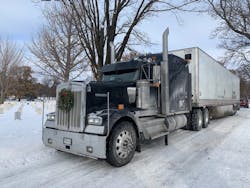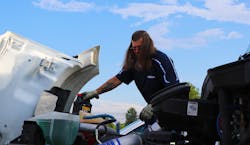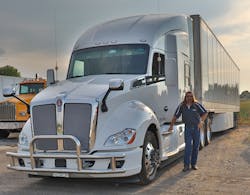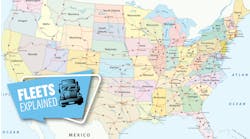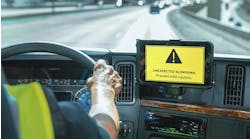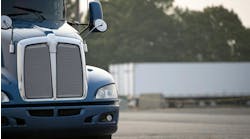There are no regrets when Bernie Gray peers into his trucking career’s rear-view mirror. The long-haired 51-year-old from the suburbs of Cleveland, Ohio, has been to 49 states (all except Hawaii) in his 30-year trucking career span, which goes back even further if his time as an Army mechanic in the late 1980s counts. Impressively, he has also accrued 3 million safe miles.
Now, Gray, (who happens to live across the street from the author) who has spent a young man’s lifetime away from his wife and two sons running chicken and produce up and down the East Coast and more recently essential cleaning supplies during the COVID-19 pandemic to Walmart locations for Dart Transportation out of Eagan, Minn., is getting wistful. He’s maybe even considering trading the cab for a desk.
“I'm ready to go in an office and be a safety person or something, where I wasn't 10 to 20 years ago,” Gray said one sunny summer day on his front porch. “I can get out of trucking now and be happy with the goals that I've met.”
Chief among these goals is owning every truck he has ever wanted, which may conclude with his recently purchased Kenworth T-680, a white sleeper dubbed “The Archangel.” A true old-school trucker from a bygone era, he’s named each rig and fondly recalls the days of “rolling coal.” Gray’s last truck, a black long hood W-900 show truck, was named the Black Pearl and reflects a candid roguish charm that will also soon be phased out as fleets inevitably move to higher levels of automation.
For now, Gray still rotates between the road and his sleepy little development, and in July he took some time to speak with us and look back at his long career.
American Trucker: How did you get started?
Bernie Gray: I got started after I got out of the Army. I was a lightweight vehicle mechanic and infantry from 1987 to 1990. I was running back and forth between bases and taking parts going to recover vehicles. And everybody said I'd be good at trucking. I didn't want to do it, but it was easier to be a driver than being an office.
Pretty much it was a family thing: My dad did it, my brother's done it, six out of eight uncles did it. My sister was also one of the first girls involved in auto tech and "impeding on a guy's territory." So I watched all of them work on stuff. And my first car was a ’72 Camaro and when I went to get it, the owner said, “If you can get it started, you can have it.” All I had to do was turn the distributor 180 degrees and it fired up and worked like a charm. From that point on I was just rebuilding and working on cars, restoring and selling them.
I eventually got away from doing mechanic work, but still gotta’ do it as an owner-operator, just on a lot bigger scale.
AT: What was your first truck?
BG: My first truck was a 1987 Cabover International 9670. It had a little 36-in. bunk with a spring ride suspension. Everything was spring ride except the seat, which was air-ride. It was painful.
AT: And now?
BG: I just bought a 2020 T680 a couple months ago. It's got a big sleeper on it, condo style. It's got pretty much all the bells and whistles. I'm really grateful now I have a built-in APU called a KIMS (Kenworth Idle Management System). It's a four-battery operating system, so you get out of a hard draw. You'll probably get eight to 10 hours out of it. If it's a mild draw, you can get up to 12 to 15 hours out of it. I've got a microwave, a TV. I got a coffee bot. I got a toaster in there. I could actually have AC or heat without running the truck and using up fuel. It's a big, big money saver. I’m probably saving 10 to 15 bucks a night.
I’m warrantied up to 450,000 miles and because I stayed with Paccar’s financial institution, they added another year. Without a warranty, you’ll go broke. If this new DEF system goes down on me without a warranty, I’m looking at $5,000 out of pocket.
I previously had a 2017 Kenworth Icon 900 Limited, number 479 of 1,000. I would do a lot longer hauls with it. I downsized to the newer truck because I try to be home every weekend, if not every other weekend.
I was getting like between four and six mpg on the old truck, where this truck here I'm getting anywhere from eight to 10 mpg.
AT: What else do you like about what’s new under the hood?
BG: It has a 510 horsepower Paccar MX-13 engine. It's got a lot of power, a lot of torque. It's teamed up with a 12-speed Eaton automatic transmission. I'm not an automatic fan, but I'm older and my knees are worn out so I switched to the automatic. I am very, very impressed.
I outpull and outrun a lot of the bigger trucks. These guys will be coming up the hill and they'll start out pull me but as soon as it starts a hill, it drops one gear from 12 to 11 and I just 'Stormtrooper' right up the hill. I've never been a fan of automatic transmissions, but I can't argue about it right now.
I use a cruise all the time. So that's the only thing I don't care for. And I've been trying to get with Paccar because it has a tendency to kick itself into neutral to for fuel economy. It’s aggravating because you'll be just about at the top of the hill and all of a sudden, it'll turn around it'll kick down because the GPS location. You'll usually lose almost eight to 10 mph before it actually kicks back in.
AT: What’s your current duty cycle?
BG: I run what they call Ohio short haul. I run off a percentage and I run mostly short loads. Usually it's like two to three loads each time, and I'm doing drop and hook, hardly any “bump the docks.” Runs are about 250 to 300 miles.
AT: How have your views on performance versus efficiency changed since you started driving?
BG: Totally opposite. In my mid-20s, it was foot to the floor, getting and going. As the old saying goes, “rolling coal and grabbing gear.” Now it's all about saving that dollar and your biggest expense as a driver is your fuel. If you can beat your fuel costs and save money there, you can make money every which way. I let everybody else go past me and fight for position. I'm a firm believer in going 60 to 65 even though the speed limit could be 70 to 75. Everybody gets on me that I'm going too slow, but the slower you go, the better fuel mileage you will get.
AT: Do you see any issues in modern trucking that may not have existed before?
BG: There’s a lack of accountability. I've seen drivers take trailers with blown tires into a customer drop because they're going to get another trailer, and then they won't even call road service to have them come visit.
One of my pet peeves is guys taking the window cleaning squeegee and washing off their tanks and everything where the fuel spilled off. That's pretty rude because the next guy's got to take and clean his windshield with that. That diesel fuel is going to eat away at your rubber trim around your windshield, it's going to eat away at your windshield wiper. Plus, it's just going to smear your windshield really bad.
I'll call guys out when they're doing stupid stuff like that. I've almost had my butt kicked one day because I got so fed up with it. I actually walked up and watch this young guy do it on his dirty tanks. I went up I grabbed the squeegee and said, “That’s pretty good, but let me do your windows for you.” I started doing his windows with the dirty squeegee and he got really mad. So I threw it on the ground at him and I said now you clean your windows with it. So he had to clean his windows because I already smeared them up.
AT: Did the pandemic help your business or hurt it?
BG: It was 50/50. It was good because I keep moving, still making good money. It sucked because other people are sitting at home making good money and enjoying the relaxation. And I couldn't; I had to go out, I was constantly out. I was afraid to come home because I could catch the coronavirus somewhere and somewhere and bring it home.
AT: How were things different out there during the peak COVID-19 conditions?
BG: I ended up being hours exempt after a few weeks, which means that my logbooks didn't exist. One of the runs I did was six hours down, three hours over to pick up the next one, eight hours back, so about 20 hours. I was running a lot of Procter & Gamble product, a lot of diapers, paper towels, baby wipes, to Walmart stores. P&G was pushing a lot of cleaning supplies.
I still had to be careful and watch how I drove and make sure I got rest. I took breaks in between loads if I could. Everybody nicknamed me “Sandman” at work because I like to stop take a grampy [or short nap]. I do a lot of eight and twos.
AT: How do you feel about the new HOS rules that go into effect Sept. 29?
BG: I'm looking forward to the new hours of service. I think back when they first changed the hours of service, if they would have just done the 34-hour restart deal and left the hours the way they were, we'd have been fine.
I’m not a big fan of a computer telling me when to sleep and when not to. Human bodies don’t work that way. I learned my limitations on my own with the logbooks. And new drivers are coming right in not running paper so they can't learn their limitations. So that's why we still have a bad accident ratio. They're told by dispatch, that they’ve got hours so they have to go. Turn it down. Don't do it. They can't fire everybody. You're gonna’ have your fleet managers and dispatchers try to flex their muscle but you’ve got to be the driver, you're the captain of your ship. You have to tell them what's gonna’ happen, and what's not.

